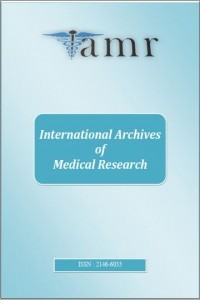Multiple Myeloma; Experience of a Center
Amaç: Multıple myelom(MM) tanısı konulmuş olan hastaların tanı anındaki demografik özellikleri, laboratuvar parametreleri, verilen tedavileri ve tedavi yanıtları toplumlar arası farklılık göstermektedir. Multple myelom hastalarının bu verilerini araştırmayı ve literatür verileriyle karşılaştırmayı hedefledik. Materyal Metot: Bu çalışmada 1 Ocak 2010-31 Ocak 2019 tarihleri arasında ..... Üniversitesi tıp fakültesi iç hastalıkları hematoloji kliniğinde MM tanısı konulmuş 272 hastanın verileri retrospektif olarak incelendi. Çalışmaya alınan hastaların tanı anındaki genel özellikleri, laboratuvar değerleri, tedavi seçenekleri, tedavi yanıtları, ortalama ve ortanca sağkalım süreleri ve mortalite nedenleri araştırıldı.Bulgular: Multıple myelom hastalarımızın alt tip analizlerinde hastaların 124’ü(%45,6) ıgG, 50’si(%18,4) ıgA, 59’u(%21,7) hafif zincir, 21’i(%7,7) plazmasitom, 4’ü(%1,5) ıgM, 3’ü(%1,1) plazma hücre lösemisi, 11’i(%4) de nonsekretuvar myelom olarak bulundu. 77 hastaya otolog hematopoetik kök hücre nakli (OHKHN) yapıldı. OHKHN yapılan hastalarda ortalama yaşam süresi 68 ay iken OHKHN yapılmayan hastalarda bu süre 42 ay olarak tespit edildi (p<0,001). En sık mortalite sebeblerini enfeksiyonlar (%55), tromboembolik olaylar (%22), hemorajik kompikasyonlar ve hastaların komorbid durumları (%22) oluşturdu.Sonuç: Myelom tanımlayıcı olayların oranları, tedavi yanıt oranları, sağkalım süreleri, OHKHN yapılan hastalardaki sağkalım süreleri ve mortalite nedenleri literatür verileriyle benzer bulundu. Tedavi yanıt oranları ve ortalama sağkalım sürelerinin yeni ajanların çıkmasıyla arttığını görmekteyiz.
Multiple Myeloma; Experience of a Center
Objective: Demographic characteristics, laboratory parameters, applied treatments, and treatment responses of patients diagnosed with multiple myeloma (MM) at the time of diagnosis vary between communities. We aimed to investigate this data of Multiple Myeloma patients and compare it with literature data. Material Method: In this study, we retrospectively examined data of 272 patients diagnosed with MM between January 1st, 2010, and January 31st, 2019 in Dicle University Faculty of Medicine Internal Medicine Hematology Clinic. At the time of diagnosis, general characteristics, laboratory values, treatment options, treatment responses, mean and median survival times, and causes of mortality of the participated patients in the study were investigated. Results: We found that 124 (45.6%) patients had IgG, 50 patients had (18.4%) ıgA, 59 patients had (21.7%) light chain, 21 patients had (7.7%) plasmacytoma, four patients had (1.5%) ıgM, three patients had (1.1%) plasma cell leukemia, and 11 patients had (4%) non-secretory myeloma. 77 patients underwent autologous hematopoietic stem cell transplantation (AHSCT). The average life expectancy in patients with AHSCTwas 68 months, while in patients without AHSCT, this period was determined as 42 months (p<0.001). Conclusion: We see that treatment response rates and average survival times increase with the introduction of new agents.
Keywords:
Myelom, New agents Transplantation, Myelom, New agents, Transplantation,
___
- 1. Hemminki, K., X. Li, and K. Czene, Familial risk of cancer: data for clinical counseling and cancer genetics. International journal of cancer, 2004. 108(1): p. 109-114.
- 2. Practice and Research Clinical Hematology, 2005. 18(4): p. 553-568.Cohen, G. And W.H. Hörl. Progress in Uremic Toxin Research: Free Immunoglobulin Light Chains as a Risk Factor in Renal and Extrarenal Complications. In Seminars in dialysis. 2009. Wiley Online Library
- 3. Dizpenzieri A, Keyl RA, Multıple myeloma: clinical features and indications for threapy, Best Practice & Research Clinical Haematology Vol. 18, No. 4, 2005, pp. 553– 568
- 4. Blimark CH, Turesson I, Genell A, et al. Outcome and survival of myeloma patients diagnosed 2008‐2015. Real world data on 4904 patients from the Swedish Myeloma Registry (SMR). Haematologica. 2017;103:506‐513
- 5. Savage DG, Lindenbaum J, Garrett TJ, et al. Biphasic pattern of bacterial infection in multiple myeloma. Ann Intern Med 1982;96: 47-50
- 6. Ludwig H, G M Durie B, Bolejack V, et al. Myeloma in patients younger than age 50 years prsents with more favorable features and shows better survival: an analysis of 10 549 patients from the International Myeloma Working Group. Blood, 15 April 2008 V 111, No: 8, 4039-4047
- 7. Jordan K, Proskorovsky I, Lewis P. et all. Effect of general symptom level, specific adverse events, treatment patterns, and patient characteristics on health- related quality of life in patients with multiple myeloma: results of a European, multicenter cohort study. Support Care Cancer (2014) 22:417–426
- 8. Kim K. et al. Clinical profiles of multiple myeloma in Asia—An Asian Myeloma Network study. American Journal of Hematology, Vol. 89, No. 7, July 2014. 751-756
- 9. Yadav P, Shemaar M, et al. Multiple myeloma can be accurately diagnosed in acute kidney injury patients using a rapid serum free light chain test. BMC Nephrology (2017) 18:247
- 10. Gundesen M T, Lund T, et al. Plasma Cell Leukemia: Definition, Presentation, and Treatment. Current Oncology Reports (2019) 21: 8 1-10.
- 11. Reece DE, Rodriguez GP, Chen C, et al. Phase I-II trial of bortezomib plus oral cyclophosphamide and prednisone in relapsed and refractory multiple myeloma. J Clin Oncol. 2008;26(29):4777-4783.
- 12. Lemieux E, Hulin C. et al. Autologous Stem Cell Transplantation: An Effective Salvage Therapy in Multiple Myeloma. Biol Blood Marrow Transplant 19 (2013) 445- 449
- 13. Attal M, Stoppa AM, et al. A prospective, randomized trial of Autologous bone marrow transplatation and chemoterapy in Multıple Myeloma. N England Journal Medicine 1996; 335:91-7
- ISSN: 2146-6033
- Yayın Aralığı: Yılda 2 Sayı
- Başlangıç: 2011
- Yayıncı: Veysi AKPOLAT
